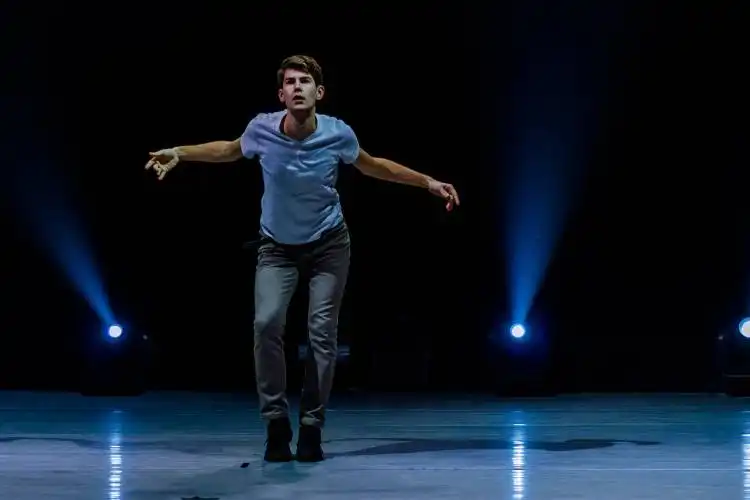Start a Dance Studio
Twirling towards prosperity: Transforming Passion into a Thriving Dance Studio Business
| Updated


DANCE STUDIO
Perfecting a pirouette or mastering the mambo may be just a hobby for you, but for a nascent entrepreneur, opening a dance studio could be your path to turning your passion into profit. A dance studio operates as an exciting space where people of all ages can learn different dance styles from trained professionals. This venture offers not only a potential financial reward but also the satisfaction of knowing you're empowering others with the ability to express themselves through the magic of movement. The business operates by offering classes, workshops, and private instruction in various dance genres, from classical ballet to hip hop and everything in between.
Jump to Business Plan
RELATED BUSINESS IDEAS
Browse ALL Music & Entertainment Ventures Business Ideas
Discover Your Perfect Domain
Unlock the door to your online success with our hand-picked selection of premium domain names. Whether you're starting a new venture or rebranding an existing one, the right domain can set the tone for your digital presence. Browse through our curated list, each with its unique potential to enhance your brand's visibility and credibility.
DANCE STUDIO MINI BUSINESS PLAN
This a quick reality check to help you identify the strengths and weaknesses of your business concept before you dive in.
Business Idea: Dance Studio
Expected Percent Margin:
- Gross Margin: 50-70%
- Net Profit Margin: 10-25%
Earnings Expectations:
- Daily Earnings: $300 - $700
- Weekly Earnings: $1500 - $3500
- Monthly Earnings: $6,000 - $14,000
- Annual Earnings: $72,000 - $168,000
Actions to Hit Those Numbers:
Studio Management:
- Initial Setup Cost: Around $10,000-$50,000 for a quality studio environment.
- Space: Lease/buy a space that's around 1,000-3,000 square feet.
Customer Acquisition and Marketing:
- Class Diversity: Offer a range of classes for different age groups and skill levels to widen customer base.
- Social Media: Regular engagement on social platforms. Hosting local community events can also be effective.
Sales Strategy:
- Membership Pricing: Offer competitive pricing with options like monthly/yearly memberships, drop-in rates, and class packages.
- Private Lessons: Private lessons can significantly boost income.
Cost Control:
- Operational Costs: Rent, cleaning, utilities, etc. should be kept under 20% of monthly revenue.
Business Operations:
- Open Hours: Open at least 5 days a week, with various class timings.
- Student Volume: Aim to maintain a strong student base of at least 100-200 students.
Please note, these numbers are ballpark figures and vary based on factors such as a location, competition, and individual business capabilities. Always consult with a financial advisor or a business consultant for personalized advice.
NOT WHAT YOU HAD IN MIND? Here are more ideas



Browse ALL Music & Entertainment Ventures Business Ideas
Grab Your Business Website Name
Before you get caught up in the whirlwind of setting up your business, invest in a domain name. It's a small but significant step that lays the foundation for your brand and makes it easier for customers to find and trust you. Just like you wouldn't build a house without securing the land first, don't build a business without securing your domain name.
"Why? Can't that wait?" Here's why it shouldn't
Step 1: Determine if the Business is the Right Endeavor
Breakdown of Startup Expenses
Starting a dance studio requires a significant investment of both time and money. Before deciding to open a dance studio, it is important to understand the startup costs associated with the venture. These costs can include the cost of renting a space, purchasing equipment, hiring instructors, and marketing the business. It is also important to consider the cost of any necessary permits or licenses, as well as the cost of insurance. Additionally, it is important to consider the cost of any renovations or repairs that may be needed to make the space suitable for a dance studio.
Breakdown of Ongoing Expenses
In addition to the startup costs, it is important to consider the ongoing expenses associated with running a dance studio. These expenses can include the cost of rent, utilities, insurance, and any necessary repairs or renovations. Additionally, it is important to consider the cost of instructors, as well as the cost of any supplies or equipment that may be needed. It is also important to consider the cost of marketing and advertising, as well as any other expenses that may be associated with running the business.
Examples of Ways to Make Money
There are a variety of ways to make money with a dance studio. These can include charging for classes, offering private lessons, hosting workshops or special events, and selling merchandise. Additionally, it is possible to make money by renting out the space for events or performances, or by offering classes for children or adults. It is also possible to make money by offering online classes or streaming services, or by partnering with other businesses or organizations.
Step 2: Name the Business
When naming a business, it is important to choose a name that is memorable, unique, and reflects the mission of the business. It is also important to make sure that the name is not already taken. To ensure that the name is available, it is important to do a thorough search of the internet and the USPTO website. Additionally, it is important to make sure that the domain name is available and that the name is not trademarked.
Once the name is chosen, it is important to register the business with the state and obtain a business license. Additionally, it is important to register the business with the IRS and obtain an Employer Identification Number (EIN). This will allow the business to open a business bank account and accept payments.
It is also important to make sure that the name is not already in use by another business. This can be done by searching the internet, the USPTO website, and the Secretary of State website. Additionally, it is important to make sure that the name is not trademarked.
Once the name is chosen, it is important to create a logo and a website for the business. This will help to create brand recognition and will help to attract customers. Additionally, it is important to create social media accounts for the business. This will help to spread the word about the business and will help to build an online presence.
Finally, it is important to register the business with the local Chamber of Commerce. This will help to create a network of other businesses and will help to create visibility for the business. Additionally, it is important to register the business with the Better Business Bureau. This will help to create a sense of trust with customers and will help to build a positive reputation.
Step 3: Obtain Necessary Licenses and Permits
Before you can open your dance studio, you must obtain the necessary licenses and permits from your local government. Depending on the type of business you are running, you may need to apply for a business license, a tax identification number, and a zoning permit. Additionally, you may need to register your business with the state and obtain a sales tax permit. It is important to research the specific requirements for your area and to make sure you have all the necessary paperwork in order.
You may also need to obtain liability insurance for your business. This will protect you in the event of an accident or injury on your premises. Additionally, you may need to obtain workers’ compensation insurance if you plan to hire employees. Finally, you should check with your local fire marshal to make sure your studio meets all fire safety regulations.
Once you have obtained all the necessary licenses and permits, you can move on to the next step in the process of opening your dance studio.
Step 4: Find the Right Location
When starting a dance studio, it is important to find the right location. This is a crucial step in the process, as the location of the studio can make or break the success of the business. The location should be in a place that is easily accessible and has plenty of parking. It should also be in an area that is conducive to a dance studio, such as near a school or a shopping center. Additionally, the location should be large enough to accommodate the number of students that will be attending classes. It is also important to consider the cost of renting the space, as this can be a major expense.
When searching for the right location, it is important to take into account the local competition. It is important to make sure that the studio is not too close to another dance studio, as this could make it difficult to attract students. Additionally, it is important to research the local zoning laws to make sure that the business is in compliance with all regulations. Finally, it is important to consider the safety of the area and make sure that the studio is in a safe and secure location.
Step 5: Purchase Necessary Equipment
When starting a dance studio, it is important to purchase the necessary equipment for the studio. This can include items such as a sound system, mirrors, dance floors, and other items that will be used for classes. It is important to research the different types of equipment available and compare prices to ensure that you are getting the best deal. Additionally, it is important to consider the size of the studio and the type of classes that will be offered when purchasing equipment. For example, if the studio will be offering hip-hop classes, then it is important to purchase the right type of sound system and flooring that will accommodate the needs of the class. Additionally, it is important to consider the safety of the equipment and make sure that it is up to code and in good condition. It is also important to consider the cost of maintenance and repair of the equipment as this can add up over time. Finally, it is important to consider the cost of insurance for the equipment as this can help protect the business from any potential damages or losses.
Step 6: Market the Business
Once the business is up and running, it is important to market the dance studio. This can be done through a variety of methods, such as creating a website, setting up a social media presence, and advertising in local newspapers, magazines, and other publications. Additionally, it is important to reach out to the local community, such as schools and other businesses, to let them know about the studio and the classes offered. It is also important to create a referral program to encourage current customers to refer new customers. Finally, it is important to create a unique brand and logo that will help to differentiate the studio from other competitors.
Step 7: Hire Instructors
Once the studio is ready to open, it is important to hire qualified instructors. The instructors should have experience teaching dance and should be able to work with a variety of ages and skill levels. It is also important to make sure the instructors have the necessary certifications and licenses. It is important to create a job description and list of qualifications for each instructor position. This will help to ensure that the instructors are properly qualified and can provide the best instruction possible. Additionally, it is important to create a contract that outlines the expectations and responsibilities of the instructors. This will help to ensure that the instructors are held to a high standard and that the studio is in compliance with all laws and regulations. Finally, it is important to provide competitive pay and benefits to attract and retain the best instructors.
Step 8: Set Tuition and Fees
Setting tuition and fees is an important part of running a dance studio. Tuition should be set based on the cost of running the studio and the amount of time and energy spent on each student. Fees should be set to cover the cost of any additional services, such as costume rentals or special events. It is important to be transparent about the cost of tuition and fees, and to make sure that the prices are competitive with other studios in the area. Additionally, it is important to consider offering discounts or payment plans for students who may not be able to afford the full cost of tuition and fees. This will help to ensure that all students have access to the studio and its services.
When setting tuition and fees, it is important to consider the cost of running the studio, including rent, utilities, and staff salaries. It is also important to consider the cost of any additional services, such as costume rentals, special events, and other activities. Additionally, it is important to consider the cost of any materials or supplies that will be used in the studio, such as music, costumes, and props. Finally, it is important to consider the cost of any marketing materials or advertising that will be used to promote the studio. All of these costs should be factored into the tuition and fees that are set.
Step 9: Create a Business Plan
Creating a business plan is the last step in starting a dance studio. A business plan is a written document that outlines the goals of the business, how it will be achieved, and the resources needed to reach those goals. It should include an executive summary, a market analysis, a description of the services offered, a financial plan, and a risk management plan. It should also include a timeline for achieving the goals of the business.
When creating a business plan, it is important to include a detailed budget. This should include startup costs, such as rent, equipment, and marketing, as well as ongoing costs, such as salaries, utilities, and insurance. It is also important to include a plan for generating revenue. This could include membership fees, class fees, and private lessons. Additionally, it is important to include a plan for marketing the business, such as advertising, social media, and word-of-mouth.
Creating a business plan is a crucial step in starting a dance studio. It helps to ensure that the business is well-prepared for success. It also helps to ensure that the business has the resources needed to reach its goals. Additionally, it helps to ensure that the business is financially viable and that it has a plan for generating revenue. Finally, it helps to ensure that the business has a plan for marketing itself and reaching potential customers.
EXPLORE MORE CATEGORIES
Browse ALL Business Idea Categories
TAKE THE NEXT STEPS










